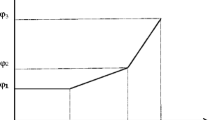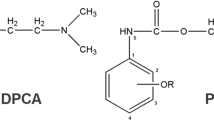Abstract
Some predictive approaches aimed at modelling the combined effect of solute molecular structure and mobile phase composition on retention in reversed-phase high-performance chromatography (RP-HPLC) have been developed in the literature. These models are established for a given binary eluent (normally acetonitrile–water or methanol–water) by non-linear (curvilinear or artificial neural network) regression assuming as the mobile phase descriptor the volume fraction φ of the organic modifier. In the present investigation, we propose a model applicable simultaneously to acetonitrile–water and methanol–water eluents. To this end, the Kamlet-Taft solvatochromic descriptors of the eluent and the solvatochromic descriptors of the analytes are considered as the input variables of a multi-layer artificial neural network (ANN) providing the solute retention as the response. This approach is applied to a set of 31 molecules analyzed with five different columns in the φ range 20–70 % at 10 % steps for both acetonitrile- and methanol-containing mobile phases. For each column, an ANN-based model is built using retention data of 25 molecules selected by the Kennard-Stones algorithm while retention data of the unselected six solutes are considered in the final evaluation of predictive performance of the trained network. To test cross-eluent prediction, the network optimized for a given column was successively trained with data collected in eight out of 12 eluents and applied to deduce retention in the four remaining mobile phases. The results reveal that RP-HPLC behavior of external solutes is quite accurately modelled in the whole explored composition range of acetonitrile– and methanol–water mobile phases. Moreover, the model exhibits a promising capability of deducing retention of external solutes even in unknown eluents.

Quantitative structure/eluent–retention relationship established by artificial neural network regression







Similar content being viewed by others
References
Nikitas P, Pappa-Louisi A (2009) J Chromatogr A 1216:1737–1755
Siouffi AM, Phan-Tan-Luu R (2000) J Chromatogr A 892:75–106
García-Álvarez-Coque MC, Torres-Lapasió JR, Baeza-Baeza JJ (2006) Anal Chim Acta 579:125–145
Héberger K (2007) J Chromatogr A 1158:273–305
Kaliszan R (2007) Chem Rev 107:3212–3246
Vitha M, Carr PW (2006) J Chromatogr A 1126:143–194
Abraham MH, Ibrahim A, Zissimos AM (2004) J Chromatogr A 1037:29–47
Kamlet MJ, Taft RW (1976) J Am Chem Soc 98:377–383
Taft RW, Kamlet MJ (1976) J Am Chem Soc 98:2886–2894
Kamlet MJ, Abboud JL, Taft RW (1977) J Am Chem Soc 99:6027–6038
Todeschini R, Consonni V (2000) Handbook of molecular descriptors. Wiley-VCH, Weinheim
Wang A, Tan LC, Carr PW (1999) J Chromatogr A 848:21–37
Torres-Lapasió JR, Ruiz-Ángel MJ, García-Álvarez-Coque MC (2007) J Chromatogr A 1166:85–96
Tham SY, Agatonovic-Kustrin S (2002) J Pharm Biomed Anal 28:581–590
Fatemi MH, Abraham MH, Poole CF (2008) J Chromatogr A 1190:241–252
D’Archivio AA, Maggi MA, Ruggieri F (2011) Anal Chim Acta 690:35–46
Carlucci G, D’Archivio AA, Maggi MA, Mazzeo P, Ruggieri F (2007) Anal Chim Acta 601:68–76
Aschi M, D’Archivio AA, Maggi MA, Mazzeo P, Ruggieri F (2007) Anal Chim Acta 582:235–242
Lu H, Rutan SC (1996) Anal Chem 68:1387–1393
Lu H, Rutan SC (1999) Anal Chim Acta 388:345–352
Cheong WJ, Carr PW (1989) Anal Chem 61:1524–1529
Barbosa J, Toro I, Sanz-Nebot V (1997) Anal Chim Acta 347:295–304
Marqués I, Fonrodona G, Butí S, Barbosa J (1999) Trends Anal Chem 18:472–479
Nigam S, de Juan A, Cui V, Rutan SC (1999) Anal Chem 71:5225–5234
Rabouan S, Prognon P, Barthes D (1999) Anal Sci 15:1191–1197
Barbosa J, Bergés R, Sanz-Nebot V (1996) J Chromatogr A 719:27–36
Barbosa J, Sanz-Nebot V, Toro I (1996) J Chromatogr A 725:249–260
Hemmateenejad B, Shamsipur M, Safavi A, Sharghi H, Amiri AA (2008) Talanta 77:351–359
Amiri AA, Hemmateenejad B, Safavi A, Sharghi H, Salimi Beni AR, Shamsipur M (2007) Anal Chim Acta 605:11–19
D’Archivio AA, Ruggieri F, Mazzeo P, Tettamanti E (2007) Anal Chim Acta 593:140–151
Sándi Á, Szepesy L (1999) J Chromatogr A 845:113–131
Sándi Á, Nagy M, Szepesy L (2000) J Chromatogr A 893:215–234
Kennard RW, Stone LA (1969) Technometrics 11:137–148
Andries JPM, Claessens HA, Vander Heyden Y, Buydens LMC (2009) Anal Chim Acta 652:180–188
Zupan J, Gasteiger J (1999) Neural networks in chemistry and drug design. Wiley-VCH Verlag, Weinheim
Marini F, Bucci R, Magrì AL, Magrì AD (2008) Microchem J 88:178–185
Derks EPPA, Buydens LMC (1998) Chemom Intell Lab Syst 41:171–184
Copyright ©1996-2001 JavaNNS Group, Wilhelm-Schickard-Institute for Computer Science (WSI), University of Tübingen
Torres-Lapasió JR, García-Álvarez-Coque MC, Rosés M, Bosch E, Zissimos AM, Abraham MH (2004) Anal Chim Acta 515:209–227
Author information
Authors and Affiliations
Corresponding author
Additional information
Published in the special issue Analytical Science in Italy with guest editor Aldo Roda.
Rights and permissions
About this article
Cite this article
D’Archivio, A.A., Maggi, M.A. & Ruggieri, F. Quantitative structure/eluent–retention relationships in reversed-phase high-performance liquid chromatography based on the solvatochromic method. Anal Bioanal Chem 405, 755–766 (2013). https://doi.org/10.1007/s00216-012-6191-4
Received:
Revised:
Accepted:
Published:
Issue Date:
DOI: https://doi.org/10.1007/s00216-012-6191-4




